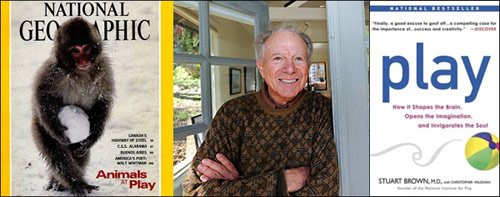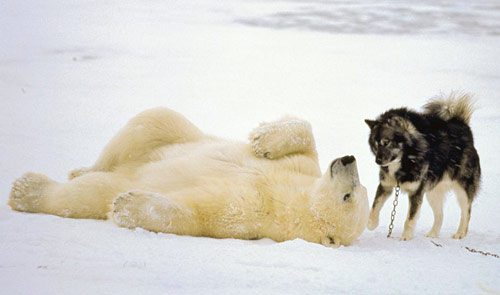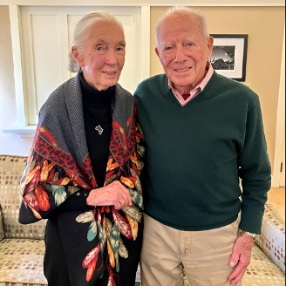
Download the entire post as PDF >
A Tribute to Stuart Brown, MD,
and The National Institute for Play
by Michael Mendizza
I got a call from my chief of service saying that I was to organize an investigation and find out why a twenty-five-year-old man, who by then had been identified as Charles Whitman, after killing his wife and mother, would shoot thirty-one people, killing nineteen, off the Texas University tower, then the largest mass murder in the United States. This was 1966, three years after the Kennedy motorcade, and Governor Connelly wanted to know what would produce this kind of tragedy.
What came out of the extensive personal interviews was that Whitman’s father sustained overcontrol and abusive family domination which meant that Charles had not ever been free to engage in spontaneous play. The commission appointed by the Texas Governor agreed that the lack of play was a significant element that led to Whitman’s inability to control and deal with his (diary confirmed) violent impulses.
The next year I headed a team that interviewed twenty-six incarcerated murders in the Huntsville State Prisons and compared them to a large matched cohort that were part of an on-going state survey that included all the young male murderers in the state of Texas. Over 90 percent of the murderers, whether they came from upper-class economic circumstances or were in a state hospital system revealed high levels of play deprivation.
If the adult culture is play-deprived, which is pervasive in Western Europe and the United States, then that adult culture is not going to allow the natural evolution of authentic play to develop in children. We see this all around us. Spontaneous (self-organized) free play in childhood has been systematically replaced by adult organized activities (and that has been replaced by technology).
Stuart Brown, M.D.
Author, PBS Producer, and Founder of the National Institute for Play
Interview with Michael Mendizza
In the mid 90s, collaborating with Joseph Chilton Pearce, physicist David Bohm and original play researcher Fred Donaldson, I had one of those flashes, an insight that ‘play’ was one of the most misunderstood activities in all of human development, yours and mine. I contacted Joe Pearce and he confirmed, decades earlier he had a similar insight.
Authentic Play, as opposed to cultural games and contests, is the over-arching umbrella in which all learning takes place. Play is the act of learning itself. Play with each stage of development involves a different type of activity. The early child plays or learns in a very different way than the middle child plays and learns, and certainly different from the late child and adolescent. Each stage of development has its own block of intelligence and abilities which are offered to us rather genetically. The development of which we do through play.
Play is the “modus operandi.” Play is the way by which all learning takes place, how we build all of our response patterns in the world, how we build the very structure of knowledge in the world itself. How to get along in it. All of this is through play.
Play is a ‘state,’ a mindset, an attitude, a condition of total openness that the child must have for real learning to take place. You might have conditioning, behavior modifications by other methods, but real learning takes place through play.
Real playing is how real learning takes place. You can have conditioning and a Pavlovian conditioning of his dogs, or behaviors modifications through other means which we look on as very serious, and we generally call learning, but it’s not learning. It’s conditioning. Real learning takes place by what Maria Montessori would call the absorbent mind of the child. Simply absorbing their universe, absorbing it, becoming it, and they do this through play.
Play can be the most serious undertaking of a child’s life. They are completely entrained in play. The three parts, thought, feeling, action, every aspect of the child’s self is entrained, focuses totally on the activity of absorbing their world. Absorbing their environment.
Play is the most serious activity of their life because they’re literally building their construction of knowledge of the world, of themselves, of the relationship between the two. Laying down all the foundations for the later forms of intelligence. In all of that, play is the activity itself.
So, you have those two things. What we think of as learning is conditioning. Training is conditioning, but real learning is that state of play. We have to interrupt the child’s real state of learning or play in order to bring about what we think should be their training, their conditioning. We make this profound error of looking on education, schooling, and all those things as dramatically separate from play. In our misperception, all we’re doing is conditioning or some forms of behavior modification, which inhibits their ability to open to and absorb the universe within them.
Joseph Chilton Pearce
Interview with Michael Mendizza
Not long after I recorded the above interview with Stuart Brown, 1994, he authored a cover story for National Geographic, ‘Animals at Play,’ with a monkey carrying a snowball, followed by his book ‘Play, How it Shapes the Brain, Opens the Imagination and Invigorates the Soul.’ Next, he founded the National Institute for Play. Stuart’s passion was to define the critical importance of authentic play throughout life, what he called ‘Play Science.’

The truth about the human species is that in body, spirit, and conduct we are designed to grow and develop in ways that emphasize, rather than minimize, childlike traits. We are intended to remain in many ways childlike; we were never intended to grow “up” into the kind of adults most of us have become.
Note: Neoteny is a biological concept referring to the retention of juvenile traits into adulthood. In simple terms, the more this retention of authentic play a species expresses, the greater their intelligence, thus the coinage of the phrase, ‘The intelligence of Play.’ Play is the way intelligence expresses.
What, precisely, are those traits of childhood behavior that are so valuable and that tend to disappear gradually as human being grow older? We have only to watch children to see the clearly displayed: curiosity is one of the most important; imaginativeness; playfulness; open-mindedness; willingness to experiment; flexibility; humor; energy; receptiveness to new ideas; honesty; eagerness to learn; and perhaps the most pervasive and most valuable of all, the need to love. All normal children, unless they have been corrupted by their elders, show these qualities all day every day of their childhood years. They ask questions endlessly; “Why?” “What is it?” What’s it for?” “How does it work?”
Ashley Montagu
Growing Young, The Genius of Childhood, Recaptured
The great rule: Play on the surface, and the work takes place beneath… Growth of intelligence is never a conscious process: conceptual changes always take place below awareness.
Joseph Chilton Pearce
Magical Child
(Montagu Continued) They watch, and they listen. They want to know everything about everything. They can keep themselves busy for hours with the simplest toys, endowing sticks and stones and featureless objects with personalities and histories, imagining elaborate stories about them, building sagas that continue day after day, month after month. They play games endlessly, sometimes carefully constructing the rules, sometimes developing the game as they go along. They accept changes without defensiveness. When they try to accomplish something and fail, they are able to do it another way, and another, until they find a way that works. They laugh. Babies learn to laugh and smile before they can even babble and children laugh from sheer exuberance and happiness. Unless they suspect they may be punished, they tell the truth: they call the shots as they see them. And they soak up knowledge and information like sponges; they are learning all the time; every moment is filled with learning. How many adults retain these qualities into middle age?
Most adults stop any conscious effort to learn in their early adulthood, and thereafter never actively pursue knowledge or understanding of the physical world we inhabit in any form. It is as though they believed that they had learned all they needed to know, and understand it all, and had found the best possible attitude toward it, by age eighteen or twenty-two or whenever they stopped their formal schooling. At this time, they begin grow a shell around this pitiful store of knowledge and wisdom, then vigorously resist all attempts to pierce that shell with anything new.
The entire effort of the educating and training of children was [and is] aimed at making adults of them as soon as possible…The closer their behavior to that of adults the better…Imagination was [and is] frowned upon, even feared; curiosity was [and is] derided; free playfulness and humor were [and is] discouraged; open-mindedness was [and is] thought to be heretical; and honesty was [and is] often considered simple rudeness. As for the most precious of all childlike qualities, the eagerness to learn; it was accepted by adults only so long as the subject was [and is] a “proper” one; otherwise it was [and is] forbidden.
Children who failed to thrive under this Spartan regime were themselves blamed for their failure [as is often the case today with the use of Ritalin and Prozac]. It occurred only to a few people that perhaps the fault lay in the failure of the adult world to understand the nature of childhood, and in fact to understand the development of human beings.
Adults fail to understand that those childlike qualities constitute the most valuable possession of our species, to be cherished, nurtured and cultivated [all the days of our lives]. They fail to realize that the child surpasses the adult by the wealth of his possibilities. In a very real sense infants and children implicitly know a great deal more concerning many aspects of growing than adults; adults, therefore, have more to learn from them about such matters than the latter have to learn from adults. Children are intermediaries, the go-betweens who, whenever we allow them to, help us discover our way toward humanity; in bringing them up we face ourselves, as in a mirror, in a clearer, brighter light.
Ashley Montagu
Growing Young, The Genius of Childhood, Recaptured
The importance of authentic or original pay was not lost on one of the premier scientists of the 20th Century, David Bohm. Far away from blocks, sand castles and the puppy-pile Dave’s appreciation came from his experience with leading scientists, their breakthrough-insights and the rigid mental blocks that transformed insight into dogma. Play and creativity are paired from the beginning.
The essential activity of science consists of thought, which arises in creative perception and is expressed through play. This gives rise to a process in which thought (and experience) unfolds into provisional knowledge, which then moves outward into action and returns as fresh perception and knowledge. This process leads to continuous adaptation of knowledge, which undergoes constant growth, transformation, and extension. Knowledge is therefore not something rigid and fixed that accumulates indefinitely in a steady way, but is a continual process of change. Its growth is closer to an organism than a data bank. When serious contradictions in knowledge are encountered, it is necessary to return to creative perception and free play, which act to transform knowledge. When creativity is made subservient to external goals, which are implied by seeking rewards, the whole activity begins to degenerate. Knowledge, apart from this cycle of activity, has no meaning (In fact, it becomes increasingly dangerous).
Creative play is an essential element in forming new hypotheses and ideas. Indeed, thought which tries to avoid play is in fact playing false with itself… The falseness that can creep into the play of thought is shown in the etymology of the words illusion, delusion, and collusion, all of which have as their Latin root ludere, “to play.” Illusion implies playing false with perception; delusion, playing false with thought; and collusion, playing false together in order to support each other’s illusion and delusions.
Within the act of creative play, fresh perceptions occur which enable a person to propose a new idea that can be put forward for exploration. As the implications of their idea are unfolded, they are composed or put together with other familiar ideas. Eventually the person supposes that these ideas are correct; in other words, he or she makes an assumption or hypothesis and then acts according to the notion that this is the way things actually are. The movement from propose to compose and suppose enables everyday actions to be carried out with little or no conscious thought….
This is appropriate only as long as the mind remains sensitive to the possibility that, in new contexts, evidence may arise that shows that these ideas are wrong or confused. If this happens, scientists [parents, or educators, caregivers, coaches] have to be ready to drop the ideas in question and go back to the free play of thought, out of which may emerge new ideas.
David Bohm, Ph.D. and F. David Peat, Ph.D.
Science, Order and Creativity
Fred Donaldson, Ph.D., a close associate of Stuart’s, is a play explorer, educator, and author of the Pulitzer-nominated book, Playing by Heart.
When I play, the identity, I know as Fred, disappears. Only when social categories disappear can real play happen. Original play is both an all-embracing vision of reality and a practice of kindness which permeates all of one’s relationships. To play in this way is to be in touch and to be touched deeply by our authentic human nature and the natural world. Original play cultivates an ever-renewing sense of enchantment and engagement with the world. It develops calmness, awareness, and a flexible ability to handle stress, surprise, or challenges without aggression.
This play develops radically different behaviors than those encouraged by the dominant contest culture. The response is deeper, more universal, and authentic. When we are in this state of original play, the limitations of our cultural identity drop away. Original play is truly an ecological intelligence. The sensitivity this play develops needs to be understood and integrated into all aspects of family, community, and professional life. Discovering the intelligence of play opens once again the genius of childhood most of us lost long ago.
Fred Donaldson, Ph.D.
Essay on Play as Belonging
Stuart’s seminal and original research began by documenting what happens when original play is repressed or absent in childhood and in adults.
A control study of twenty-six adult homicidal males, anecdotal playground and family reports revealed a near absence of normal rough and tumble playground anarchy. Members of the “normal” and nonviolent comparison control group provided descriptions of give and take, winning and losing in playground games, and participants often remembered the names and characteristics of buddies with whom they had rough and-tumbled experiences. None of the violent males remembered a playground buddy.
Drawing on 6000 play histories of a wide variety of individuals, I predicted that rough and tumble play, and its natural following social competencies, prepares those who successfully enjoyed that activity for a more flexible, socially competent future.
Similar play behavior is seen in the wild. When an adult Silverback gorilla, for example, enters the play-space, it is usually to break up a real fight that began as rough and tumble play. When juvenile primates sense danger or that no adult is “on call” to break up a serious situation the play also ceases.
For primates and for human beings, an adult in the wings, but not on scene creates the “safe place” for this high-energy play to unfold. When our children whoop it up in rough and tumble activities, most adults become uncomfortable. Their discomfort and need to take “responsible control” usually ends the free play for kids. Surveys of young adult female teachers show their general anxiety in the presence of, and lack of accurate “knowledge about,” this important developmental play-behavior. Adult “organized” play activities, including sports, do not replace the freedom and exuberance or provide the developmental rewards gained from open, adult-at-a-distance rough and tumble play. Rough and tumble play is important to children and it is important that adults understand and create the safe place for this free-range, vigorous activity.
Stuart Brown, M.D., interview with Michael Mendizza

Stuart describes how each of us has an inherent ‘play nature’ that is as unique as our fingerprints. Our play circuits create our “play nature” — the preferences we have for particular types of play such as movement play, object play, or social play. As we grow, those preferences expand, interact, and, if not suppressed, lead to our play personality.
The more that very young children are able to act from their ‘play nature,’ the better they will develop and reinforce the neural circuits in other parts of their brain — circuits that become the neural pathways of many life skills. The more adults act from their play nature, the greater their overall well-being. Adults who do not regularly activate their play nature may experience their lives as tinged with depression, and may lack the optimism, adaptability and resiliency to perform well in their work and family lives. In a very tangible way play deprivation is sensory deprivation.
Violence involves two fundamental issues. One is the bonded and unbonded child. The other is full gender equality. Until women are able to control their own body, and not just reproduction, but the whole spectrum of their sexuality, it will be very difficult to achieve the first step, which is the bonded child. Look at all the violence against women, the rapes, domestic violence, battered women, it’s epidemic, as is child abuse and neglect. What causes the anger and rage which leads to this violence? The ability to experience joy and pleasure.
With the basic trust that affectionate pleasure (and authentic play) develops we respond more openly to life and to change. People who are rigid, highly armored, are limited in their capacity to feel empathy, compassion or adapt to change, which translates into a lack of bonding and limited capacity to nurture others.
Repression of pleasure (play deprivation) sets up the reservoir of rage; and our belief systems create the target. Both work together. The sensory deprivation of (play and) pleasure results in the failure of certain neural pathways to properly develop. Sensory stimulation acts like a nutrient for brain growth and development. The richer the networks, the greater the interconnectivity and neural integration of the brain. If we do not get the sensory stimulation we equate with love, bonding and intimacy during the formative periods of brain development, we will be impaired, if not crippled in our ability to experience and express this “language of love” later in life.
By depriving intimate body contact between mother and infant, the sensory systems needed to experience pleasure, bonding and love (and therefore play) were starved. Harlow created emotionally, socially and sexually dysfunctional animals. They became pathological as juveniles and adults. Their reproductive systems were intact, but the emotional and social skills we associate with love and bonding (and play) were destroyed. No mammal, except the human mammal separates the newborn from its mother.

Bonding is the essence and foundation for play, knowing that we are both safe and loved
allows us to embrace, explore and learn. That’s play.
Bonding creates the sensory and emotional environment that shapes how we interpret and respond to relationships lifelong. Break the bond at the beginning and we set the stage for cycles of depression, anger, rage, substance abuse and violence, generation after generation.
James W. Prescott, Ph.D.
Brain & Behavior Neuroscientist, Anthropologist with Michael Mendizza
Following nature’s design every second of the 10,000 hours of practice on the ever-expanding road to mastery would be accomplished in the state of real play, free from the ternary of contests, comparisons, punishments and rewards. Original play is the only state where our true genius and unlimited capacities unfold: curiosity; imaginativeness; open-mindedness; willingness to experiment; flexibility; humor; energy; receptiveness to new possibilities; honesty; eagerness to learn; and perhaps the most pervasive and most valuable of all, the need to love. As Joseph Chilton Pearce observed, “there is no failure possible in the state of play.” Optimum learning and performance, in any age, stage or activity, happens when we are free to give complete attention to the challenge de jure, in the moment, free from the curse of ‘what will they think of me.’
In his passion and quest to define “Play Science,” Stuart attracted and wrapped his vision with some of the most distinguished Neuroscience, Behavioral and Ethology (animal) researchers in the world:

Jane Goodall, the world’s best-known woman scientist, was a longstanding member of NIP’s board. She received many honors for her pioneering work in primatology, and was recently selected as humanitarian of the year by the United Nations. Stuart Brown served on Jane’s board of directors for many years.
Jaak Panksepp’s pioneering studies of human and animal emotions demonstrated that play behaviors are part of the subcortical wiring of the brain.
After training with Jaak Panksepp, Jeff Burgdorf dedicated his research career to the neuroscience of emotions — particularly positive emotions — and their genetic expression.
A legendary psychologist known for his research on creativity, happiness, and positive psychology, Mihaly Csikszentmihalyi is most widely known for his theory of “flow” — a play state that involves intense absorption in a challenging and enjoyable activity.
One of the founders of modern neuroscience, famous for her discovery of definitive evidence of neuroplasticity, Marian C. Diamond revolutionized the study of the human brain and proved that play is fundamental to human learning.
Dr. David Elkind is recognized by the general public for his work popularizing the importance of play to children’s learning and healthy development.
Gordon Burghardt is a play scholar whose work is both rigorously scientific and startlingly original. The Genesis of Animal Play (MIT Press, 2005) is a comprehensive, detailed examination of play in a wide variety of species, including humans, and explores both the origins and the evolution of play behavior.
Robert “Bob” Fagen’s primary research interest is the biology of animal play. His book Animal Play Behavior is the definitive text on the subject. His scholarly work describes, explains, and interprets play in the animal world and explores its meaning from ethological and evolutionary standpoints.
From her earliest research into how infants learn language, Dr. Roberta Golinkoff has been passionate about helping the public understand the science of child development and learning. She has written 16 books and hundreds of publications, including the award-winning Einstein Never Used Flash Cards (Emmaus, PA: Rodale, 2004).
Brian Sutton-Smith was arguably America’s most prolific and influential play scholar, and was widely regarded as the world’s foremost play theorist. His tireless scholarship helped legitimize play and children’s folklore as topics of scholarly interest and produced more than 50 books and 350 articles on play theory, children’s folklore, and children’s games, as well as encyclopedic literature reviews and longitudinal studies of play behavior. And the list goes on…
Modest and self-effacing Stuart Brown, stunned by what he discovered about twenty-five-year-old Charles Whitman, synthesized an array of different lenses or perspectives, defining the new field of ‘Play Science.’ In a touch and play-deprived world, Stuart has awakened new respect, support and encouragement for nature’s most powerful evolutionary thrust, messing around, watching what happens, adapting, and messing around again, and again, with joy, complete attention and affection.
The challenge is now to turn the world on its end by replacing punishments and rewards, comparison and shame, with this magical, error-free state of expanding relationship called Play. Redefining and unify each parent-child, each educator-student, each coach-player and each husband and wife relationship with play’s basic trust, mutual respect, passion and timeless care. Then, stand back and watch with wonder what happens.
m